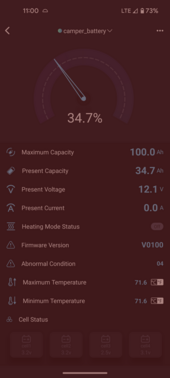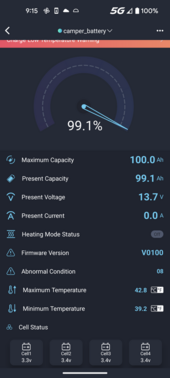caseyzak24
New Member
- Joined
- Aug 9, 2022
- Messages
- 3
Hey all,
Apologies in advance for the long/sob story but I'm hoping you all can point me in the right direction....
I bought and installed a Renogy 100Ah LFP battery w/ bluetooth (RBT100LFP12-BT) for our Casita travel trailer in late summer 2022. I got it on sale, I believe because it was their older (1st gen?) model. Shortly after, we went on the road full time and the battery worked without issue for about 9mo. In that time, IIRC, we took SOC down into the single digits a few times without issue (one of the great things about LFP). Around July of 2023, the battery shutoff around 30% while discharging in the evening, and when it kicked back on the next day the BT app showed at least the cell undervoltage warning had tripped. This happened again, so then I forced it and got a screen shot showing it was tripping the cell undervoltage protection at 2.5V (attached). One thing that was different around this time was that, we were running our 3 way fridge on DC because it was summer with great solar resource. I mention that in case it matters but even with the fridge the load was <20A. Of course, first thing I did was reach out to Renogy, filed a warranty claim, etc. It took me a while to get them the battery since we were on the road, but I finally did in early September 2023. It took 4 months to get a replacement and it was kind of a nightmare; first they told me the battery was bad and they would replace it, then they told me the battery was good and they were sending it back to me. Eventually they sent me a new battery, I think just to get me to stop calling.
I received the new battery in mid December but only got a chance to start messing with it recently. I charged it up to full charge using the LFP-specific converter on the Casita and let it sit there for a few days. Yesterday I unplugged the charger and turned on every load I could think of (fridge, lights, fan etc). According to the BT app it was a draw of 22A. Came back a few hours later and this new battery had shutoff at 20%! Once it turned back on with the charger it showed the cell undervoltage warning and one of the cells was at 2.3V, so pretty sure its the same issue. Since I already suspected the high/long draw from the fridge might matter, I charged up a few percentage points and then tried again with the fridge off, reducing the draw to 7A. I hoped this might allow things to balance out but this time the battery made it to 18% before shutting off (sigh) though that could be because I hadn't completely "zeroed-out" the previous imbalance.
Having now looked around on the forum a bit, it seems like cell imbalance is part of the deal with bargain plug-and-play LFP batteries, but most folks encounter it at the top of the charge, and in this case it is reducing the usable capacity that I thought I paid for. What's more, the manual even describes a "typical" discharge as a constant draw of 30A! So I'm not even loading it at a typical level. At this point, I'm unwilling to go through the rigamarole with Renogy again, so depending on what you all say I am willing to live with the reduced capacity, but I am wondering:
- Is this normal? Renogy eventually said that my first battery was tested and was fine. This one is brand new and experiencing a similar issue. Is this actually expected and I am just misunderstanding the spec/manual?
- Could this be a result of how my setup is wired? For context, I have a completely separate solar+battery setup in our tow vehicle. It uses the same model of Renogy battery and it has never had an issue with cell undervoltage. I have a DC plug and 3 way switch in the camper so I can run off either system. But in the camper, the wiring setup is a little wonky due to space constraints. There are some long runs that use either 2 or 4AWG. Could differences in wire resistance on the positive and negative terminals lead to imbalance? Doesn't seem likely but...
- Is there anything generally I can do to improve the situation?
Thanks!
Apologies in advance for the long/sob story but I'm hoping you all can point me in the right direction....
I bought and installed a Renogy 100Ah LFP battery w/ bluetooth (RBT100LFP12-BT) for our Casita travel trailer in late summer 2022. I got it on sale, I believe because it was their older (1st gen?) model. Shortly after, we went on the road full time and the battery worked without issue for about 9mo. In that time, IIRC, we took SOC down into the single digits a few times without issue (one of the great things about LFP). Around July of 2023, the battery shutoff around 30% while discharging in the evening, and when it kicked back on the next day the BT app showed at least the cell undervoltage warning had tripped. This happened again, so then I forced it and got a screen shot showing it was tripping the cell undervoltage protection at 2.5V (attached). One thing that was different around this time was that, we were running our 3 way fridge on DC because it was summer with great solar resource. I mention that in case it matters but even with the fridge the load was <20A. Of course, first thing I did was reach out to Renogy, filed a warranty claim, etc. It took me a while to get them the battery since we were on the road, but I finally did in early September 2023. It took 4 months to get a replacement and it was kind of a nightmare; first they told me the battery was bad and they would replace it, then they told me the battery was good and they were sending it back to me. Eventually they sent me a new battery, I think just to get me to stop calling.
I received the new battery in mid December but only got a chance to start messing with it recently. I charged it up to full charge using the LFP-specific converter on the Casita and let it sit there for a few days. Yesterday I unplugged the charger and turned on every load I could think of (fridge, lights, fan etc). According to the BT app it was a draw of 22A. Came back a few hours later and this new battery had shutoff at 20%! Once it turned back on with the charger it showed the cell undervoltage warning and one of the cells was at 2.3V, so pretty sure its the same issue. Since I already suspected the high/long draw from the fridge might matter, I charged up a few percentage points and then tried again with the fridge off, reducing the draw to 7A. I hoped this might allow things to balance out but this time the battery made it to 18% before shutting off (sigh) though that could be because I hadn't completely "zeroed-out" the previous imbalance.
Having now looked around on the forum a bit, it seems like cell imbalance is part of the deal with bargain plug-and-play LFP batteries, but most folks encounter it at the top of the charge, and in this case it is reducing the usable capacity that I thought I paid for. What's more, the manual even describes a "typical" discharge as a constant draw of 30A! So I'm not even loading it at a typical level. At this point, I'm unwilling to go through the rigamarole with Renogy again, so depending on what you all say I am willing to live with the reduced capacity, but I am wondering:
- Is this normal? Renogy eventually said that my first battery was tested and was fine. This one is brand new and experiencing a similar issue. Is this actually expected and I am just misunderstanding the spec/manual?
- Could this be a result of how my setup is wired? For context, I have a completely separate solar+battery setup in our tow vehicle. It uses the same model of Renogy battery and it has never had an issue with cell undervoltage. I have a DC plug and 3 way switch in the camper so I can run off either system. But in the camper, the wiring setup is a little wonky due to space constraints. There are some long runs that use either 2 or 4AWG. Could differences in wire resistance on the positive and negative terminals lead to imbalance? Doesn't seem likely but...
- Is there anything generally I can do to improve the situation?
Thanks!




